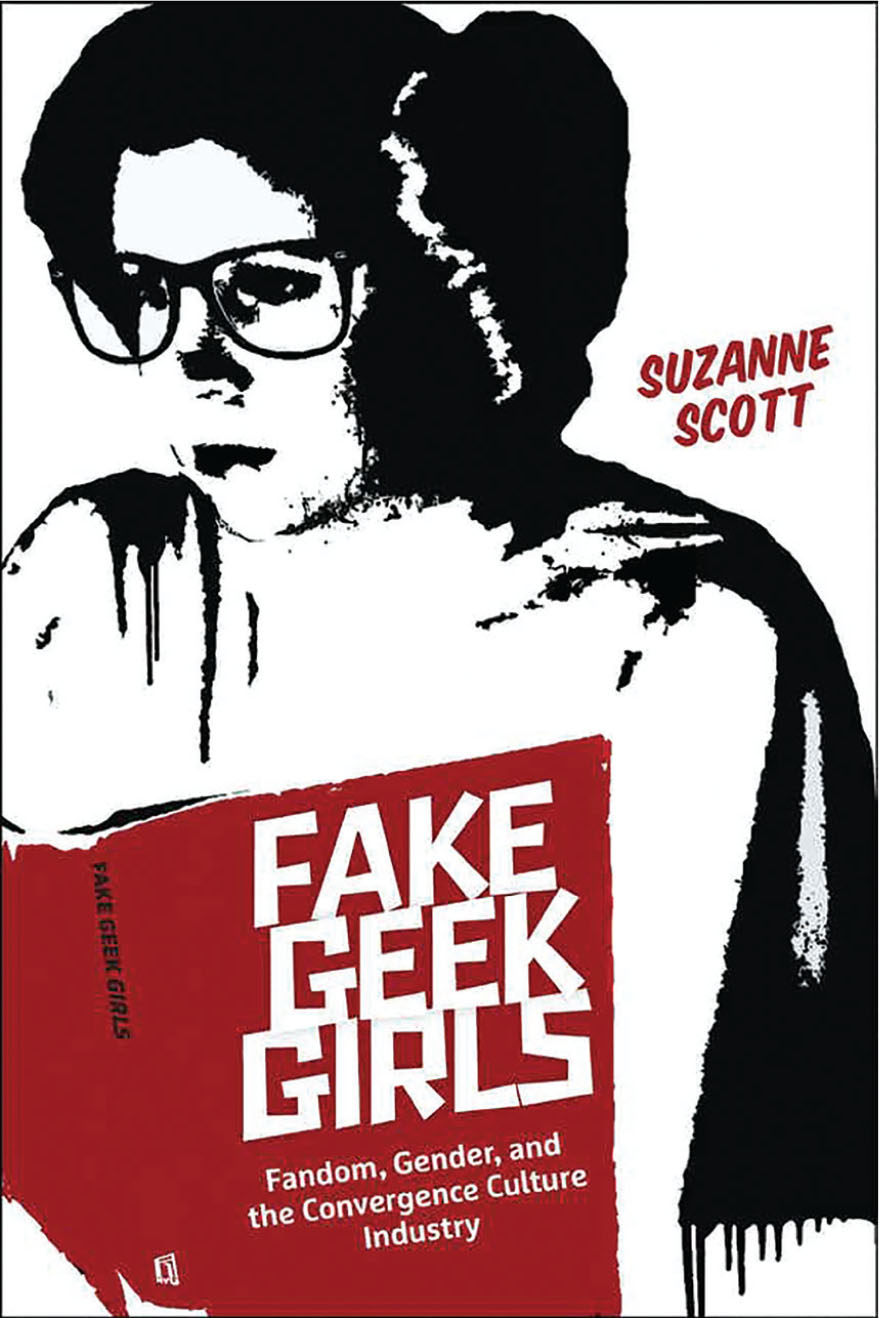Book Review
Scott, Suzanne. Fake Geek Girls: Fandom, Gender, and the Convergence Culture Industry. (New York: New York University Press, 2019.)
Skip other details (including permanent urls, DOI, citation information)
: This work is licensed under a Creative Commons Attribution-NonCommercial-NoDerivatives 4.0 International License. Please contact mpub-help@umich.edu to use this work in a way not covered by the license.
For more information, read Michigan Publishing's access and usage policy.
The subject of Suzanne Scott’s Fake Geek Girls is as timely as its cover, alluding to the loss of feminist cultural icon Carrie Fisher and the adoption of General Leia as a symbol of feminist resistance to the election of Donald Trump.[2] Like the Women’s March, the subject of her first chapter, Scott’s book acts as resistance to the persistent vilification of fangirls, seeks to reestablish fangirls’ influence on both culture and cultural studies, and examines the persistently aggressive gendering of American fandom today. She carefully grounds her analysis in the history of the field, using the existing body of fan studies scholarship in her examination of gender and fandom while demonstrating the shortcomings of that body of research with regard to continuing discussions of gender and feminism. Scott warns readers that the growing pains of fan studies may (inadvertently? perhaps; dangerously? certainly) marginalize the voices of the primary subjects long recognized as foundational. And so, the book as a whole is a challenge as much as it is a history—a focusing of subject to continue discursive analysis of gender. With that focus, Scott calls attention to other marginalized identities that require similar scholarly attention and examination, despite the “post” narrative of fandom that has privileged white heteronormative masculinity.
Fake Geek Girls functions both as an introduction and as fresh analysis. Each chapter begins with a careful mapping of the work that is been done, both in the present text and in the field at large. Scott does not call for dismissal or cold shoulders, but building and refocusing, drawing attention to work that still needs to be done on subjects that may be overlooked. This approach is useful, not only as she forwards notions like spreadable misogyny but also as she examines the corporate legislation and boxing of fandom in chapter 5 and the inherent gendering of fan production regulation in chapter 6.
The title of chapter 1, “A Fangirl’s Place Is in the Resistance,” versus “A Woman’s Place Is in the Kitchen,” engages with the historic dismissal of women’s cultural value. This chapter’s main concern is the historic practice of devaluing women’s work in emerging fields, disciplines, and occupations. Just as Victorian-era physicians instructed women on giving birth, Scott sees in the evolution of fan studies the potential remarginalization of the fangirls’ labor. In the model of Incorporation/Resistance, the products of fandom are seen by early fan studies scholars as tactically resistant, “salvaging fans and fandom as viable subject of academic study” by “removing the taint of consumption” and “stressing that fans are consumers who are also (unofficial) producers.”[3] Yet as scholars begin to challenge this dichotomy, Scott argues that the nuance and significance of gender are lost in subsequent theoretical treatment. To this point, chapter 1 considers the evolution of fan studies over a decade, tracing theoretical growth, discord, and the still-present divisions within the field.
Chapter 2 describes the evolution of the fanboy figure in popular media, from the 1986 Saturday Night Live sketch in which William Shatner dismissively tells Trekkies to “Get a life!”[4] to the scapegoating of fangirls as a demographic responsible for “ruining” fandom for their sense of “entitlement.”[5] As fandom becomes mainstream and fans become more empowered, the imbalance of gender roles is reenacted; in these representations, Scott identifies the silencing of fangirls and the erasure of their cultural contribution. The resultant “fake geek girl”[6] is at the heart of chapter 3, as Scott interrogates fandom’s toxic masculinities and the marginalization of fangirls through spreadable misogyny.[7] Scott’s concept of “spreadable misogyny” resonates strongly throughout the victim-blaming[8] evident in patriarchal abuse narratives, as femme users lacking institutional and/or regulatory support are forced to leave techno spaces out of self-defense and self-preservation. Through this lens, Scott reads examples of internet culture, most specifically the “Idiot Nerd Girl” meme, that emphasize and normalize misogyny. These texts diminish the agency of fangirls, gatekeep fandoms, and condemn gendered fan identities as being responsible for changes or products that users disavow.
A maker’s fandom is consistently contentious, as by definition they work with an established intellectual property in their own creative output. Questions of ownership and originality, but also the creative output’s value, overshadow spaces that seek legitimization from both maker and fan communities. The same can be said for both cultural makers[9] and material makers,[10] and each must contend within fandom and entrepreneurial spheres. Scott addresses the policing and restriction of fan productions in chapters 4 and 5. The “Terms and Conditions”[11] that regulate “legitimate” fan collaboration
strategically excluded . . . the female creators and consumers of slash fanfiction, fanart, and fanvids, but they more generally encompass female fans, their reading practices, and their gradual exclusion as “legitimate fans” in the convergence culture industry’s emerging collaborationist model.[12]
Parallel to this question of legitimacy is the fan’s opportunity to commercialize their efforts, professionalizing their fandom in a capitalist economy. Just as men’s labor historically has been monetarily rewarded in the workplace, while women’s labor has been devalued,[13] Scott’s fifth chapter considers the gendered politics of professionalization for the “fanboy auteur” and the “fantrepreneur,”[14] arguing that “the capacity to leverage one’s own fan identity for professional gain overwhelmingly favors men.”[15]
The question that opens chapter 6 is one that further connects the project of the book to other fields within gender studies, as Scott asks “Where does the convergence culture industry carve out space for female fans, and must we view any acknowledgment of female fans as inherently positive or progressive?”[16] The answer to the first is, briefly, fashion—a field, expression, and commercial industry contentious on just about every level and a subject of constant consideration and negotiation in examinations of gender and identity practices. Here is one space that “women have historically been and continue to be hailed as legitimate and valued consumers,”[17] but that has also been delegitimized for its feminine characterization, often deemed frivolous and shallow. To explore these stereotypes and compare them with active fandoms, Scott turns to Pinterest, a predominantly femme social media platform, to consider how “the development of strategic pinning practices might enter into or punctuate the convergence culture industry’s valuation of female fans,” where “the critiques are not strictly relegated to branded merchandise but allude to broader concerns about how the convergence culture industry is branding fandom.”[18]
From Pinterest Scott moves into material culture, examining the femme products of everyday cosplay, acknowledging the institutions that forward products, but more specifically reading the products themselves as cultural objects that convey meaning. Significantly, the analysis here focuses on fan meanings, not fashion. Scott isolates the subjects of fandom and everyday cosplay from broader considerations of fashionable aesthetics and timely evolution; this approach effectively supports the project of the text without disregarding broader interpretations. Although there are several answers to “why not a bubble skirt,”[19] Scott’s reading of femininity logically and compellingly connects deception and fake geek girls, demonstrating the various functions of everyday cosplay and fan fashion. Scott acknowledges the complexity of femme fashion and the male gaze through her analysis of trompe-l’oeil dresses and The Hawkeye Initiative’s feminist project of inversion which seeks to challenge femme representation.
The book’s approach is complex, just as the subject matter it explores. The introduction adheres to traditional binary definitions of gender, arguing that “while any fan who does not conform to the archetypal ‘fanboy’ demographic has unquestionably felt the impact . . . women have felt the brunt of these efforts most acutely.”[20] The gendering of the subject matter is admittedly heteronormative, as Scott goes on to say that she hopes Fake Geek Girls “will be productive for future considerations of racism, ableism, ageism, sizeism, homophobia, xenophobia, and transphobia within fan communities”—clearly indicating these subjects are outside the book’s scope.[21] While the dichotomy of “fanboy” and “fangirl” is descriptive and productive in its usage,[22] the isolation of women as the most impacted population potentially alienates femmes of other gender identities and suggests a categorical “real” woman over gender-fluid, gender-nonconforming, and trans femmes.[23] This problem is one of language, as the field of gender studies continues to evolve; terms like “women” and “female” as categorical markers have been used to exclude non-cis femmes from feminist discourse and privilege AFAB (assigned female at birth) identities over other femme identities of the gender spectrum. As Scott rightfully interrogates the feminization of fan studies and the feminist work within it, it is equally important to include femme fans alongside cis, heteronormative women in these discussions of gender.
The book’s conclusion makes space for further development of this and other interrogations. Scott’s final words focus on privilege, both the privilege that scholars seek to unpack and challenge, and the privilege that we scholars bring into our own work. Acknowledging the privilege of identity and fandom in a work on fan studies, Scott states, “we are quick to foreground our own self-identification as fans in our work, but are less inclined towards being similarly forthcoming about how our lived identities and fannish predilections shape the work we do.”[24] Here at the end Scott discusses “Fan Fragility,”[25] but also makes an effort to extend the conversation toward further intersectionality, speaking to the gaps in her own work and naming scholars and work that are seeking to fill these needs. Ultimately, the conclusion is effective for establishing the book as what it is: a corner piece in a puzzle, productive in its own right, and helpful for further building.
A. Luxx Mishou is an adjunct instructor at the United States Naval Academy and a PhD candidate at Old Dominion University, where she is completing her dissertation on materiality and performative villainy in the Victorian Gothic and Batman comics. A Victorianist in name, she specializes in gender studies, fashion, and materiality. Her recent publications appear in Fashion and Material Culture in Victorian Popular Fiction and Periodicals (Edward Everett Root, 2019) and The Wilkie Collins Journal (vol. 16, 2019). Her forthcoming work examines the evolution of cosplay studies and the figure of Catwoman and the censoring of the femme form.

Suzanne Scott, Fake Geek Girls (NY: New York University Press, 2019), 25.

Scott says this advice is “at worst . . . reminiscent of a range of other discursive victim-blaming tactics (‘If you don’t want to be raped, you shouldn’t dress like that.’),” 88.

A clumsy term I am using to describe fannish and artistic output such as fanfic and visual art.

Another clumsy term on my part, to refer broadly to cosplayers, costumers, and other producers of physical and material fancentric products.

Both in the same workplaces and in the second shift of domestic labor, caregiving, and so on.

A poignant example is Scott’s discussion of Gamergate (pp. 18–20) and Zoe Quinn, its principle figure. Three years after Gamergate made headlines, Quinn came out as agender (January 2017), inciting further fury and harassment as trolls began to attack the game developer’s gender identity as fervently as they attacked Quinn in 2014 (https://theralphretort.com/five-guys-adds-hot-dog-menu-zoe-quinn-now-agender-1013017/). Scott’s book uses she/her pronouns instead of Quinn’s preferred they/them pronouns, misgendering Quinn even as Scott uses Quinn’s experience as an illustrative example of the gender wars of fandom. I argue that Scott’s intentions and arguments are just as relevant for a discussion of the agender femme Quinn as they are the “females” Scott names as her primary subject.



